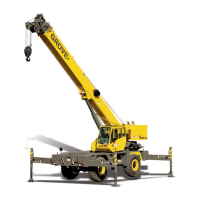POWER TRAIN 2250 SERVICE/MAINTENANCE MANUAL
7-12
Published 07-19-16, Control # 249-01
ENGINE BELT ROUTING
See Figure 7-11 for the following.
Follow the engine belt routing when installing a new belt.
DIESEL PARTICULATE FILTER (DPF)
REGENERATION
General
The diesel particulate filter (DPF), located at the rear of the
upperworks, captures soot and ash from the engine exhaust.
• Soot is partially burned fuel particles that occur during
normal operation (black smoke).
• Ash is partially burned engine oil particles that occur
during normal operation.
Over time, both soot and ash are collected in the DPF and
must be removed as follows:
• Soot is removed by a process called regeneration.
• Ash is removed by manually cleaning the DPF at
specified intervals (see the engine manufacturer’s
manual for detailed instructions).
Regeneration
General
Regeneration is the process of converting the soot collected
in the diesel particulate filter (DPF) into carbon dioxide. Heat
is required for regeneration to occur. Two types of
regeneration are used—passive and active.
Passive Regeneration
Passive regeneration occurs when exhaust temperatures
are naturally high enough to oxidize the soot faster than it is
collected in the diesel particulate filter (DPF).
The process typically occurs when the crane is operated at
high speeds and/or under heavy loads.
The operator will not know when passive regeneration is
occurring.
Active Regeneration
Active regeneration occurs when exhaust temperatures are
not naturally high enough to oxidize the soot faster than it is
collected in the diesel particulate filter (DPF). If this happens,
the engine’s controller initiates the process (see the engine
manufacturer’s manual for detailed instructions).
The process occurs more frequently in cranes operated at
low speed, light or no load, and stop-and-go cycles.
During active regeneration, the operator may notice an
increase in turbocharger noise and an increase in exhaust
temperature (High Exhaust System Temperature light
illuminates).
NOTE: Inhibit regeneration by using the Selective Catalytic
Reduction (SCR) switch only in circumstances in
which it is desirable to disable active regeneration.
Prolonged engine operation with regeneration
inhibited causes the DPF to fill with soot. Too much
soot could cause the engine to stop. If that occurs,
it will be necessary to clean the DPF before the
engine can be restarted.
Stationary Regeneration
Stationary regeneration is a form of active regeneration that
is initiated by the operator when the crane is parked. The
Selective Catalytic Reduction (SCR) light illuminates to alert
the operator if regeneration is required (see Section 3 of the
2250 Operator Manual and the engine manufacturer’s
manual for detailed instructions).
FIGURE 7-11
Item Description
1 A/C Compressor
2Idler
3 Alternator
4 Tensioner
5 Water Pump
6 Tensioner
7 Harmonic Balancer
Belt #1
Belt #2

